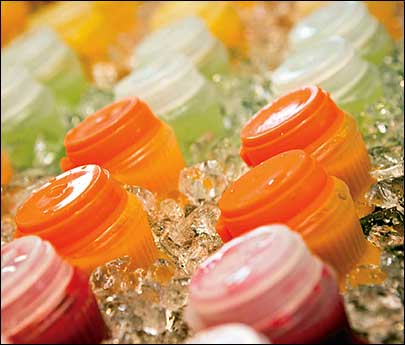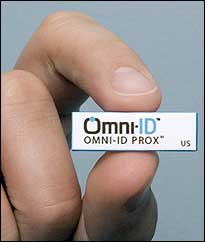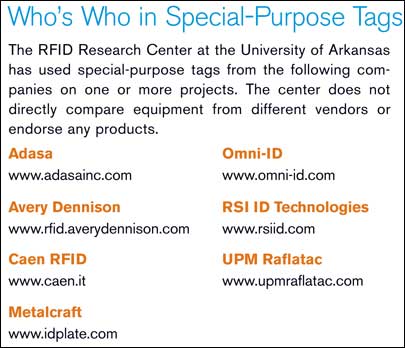One of the most common questions we get from companies looking to use Gen 2 ultrahigh-frequency passive tags in the supply chain is: “How do I read my tagged product if it has high water or metal content?”
The problem, simply stated, is that metal reflects RF energy, and water absorbs RF energy. RFID tags and interrogators communicate with each other through transmission of RF energy in the form of electromagnetic waves. When RF energy is reflected by metal, the waves interfere with themselves, decreasing efficiency. When this interference occurs, the interrogator cannot understand the message in the signal. And when RF energy is absorbed by water, its power is reduced to a level insufficient for communication.
|
|
It doesn’t take a lot of metal or water to cause problems with read rates. Sometimes companies are surprised to learn that the packaging for their products is the culprit. For example, corrugated boxes of dishwashing powder are notoriously difficult to read because of the metal-foil lining in the box. Even the metallic ink on packaging for DVDs, toothpaste and many other products reduces read rates.
Here at the lab, we often use certain “tricks” to achieve good readings. And when those fail, we turn to another solution: special tags designed for metal and water products.
Tricks of the Trade
When dealing with hard-to-read products, we first try to find the optimal location—or “sweet spot”—on the case or package where a conventional passive tag will work effectively. The RFID Research Center uses a sweet-spot tester that provides a visual representation of proper tag location. This device is not available commercially, but companies can test for the sweet spot using their own tags and interrogators. Here’s how:
1. Place a tag on a piece of cardboard and hold it in front of a reader antenna for a few seconds. Note the number of times the tag was read in a given time period.
2. Place the same tag on the product in a test location, and note the number of reads in the same amount of time. A minimum acceptable read rate would be more than 50 percent of the reads obtained in step 1.
3. Repeat this process until a usable tag location is found.
We have used this manual method on a variety of products with good results.
Another “trick” we’ve discovered concerns tagged products that are difficult to read at a pallet level. Often they can be read once the pallet is broken down into individual cases or items. This became clear when we tested large plastic buckets of paint, which contain high amounts of water. By placing a tag on the lid, we were able to read the individual buckets. But when the buckets were stacked on a pallet and the tags on the lids were covered by the buckets above them, we were unable to read the individual buckets on the pallet.
This is satisfactory if it’s sufficient to read just the pallet tag when the pallet passes through an RFID portal. But if it’s necessary to read every case or item on the pallet, you’ll probably need to use special tags designed for metal and water products.
Special Tags for Special Products
Some products are simply incompatible with conventional passive UHF tags, despite placement and orientation. In such cases, the use of a special tag is almost mandatory. The good news is that more tags designed for metal and water products are available on the market—and the performance of these tags has increased. We’ve even been able to tag and read decorative underplates, composed entirely of metal.
There’s one main difference between a conventional UHF passive tag and a tag that’s specially designed to work with metal and water: A special-purpose tag is usually inserted inside or on top of an isolating material, which offsets it from the product being tagged. The isolating material protects the tag from the detuning/absorbing effects of the material to which it is applied. The isolating material can be plastic, foam, paper—even metal—as long as the tag is sufficiently offset from the product beneath it.
Metalcraft and UPM Raflatac take a slightly different approach to isolating the tag from the surface of the product: An adhesive label combines with a folding tab, which offsets the inlay. The adhesive label sticks to the product, and the tab containing the tag hangs in the air perpendicular to the surface of the product. These tags are often referred to as “flag tags,” because they hang off the product like a flag. They can be very useful for many applications, but because of their exposed profiles, they might not be the best choice for products that will be exposed to rough conditions.
Although it may seem counterintuitive to use metal in the construction of a special-purpose tag, metal is, in fact, commonly used to improve readability. A calibrating strip of metal is often included where the tag will contact the surface of the product. The tag itself is specially tuned for the thickness of the isolating material and the properties of the calibrating strip; therefore, the strip effectively “masks” the properties of the metal surface beneath it.
Caen RFID and RSI ID Technologies (now owned by Sirit Technologies) offer metal-backed tags. We often use these tags for permanent pallet-rack tags, which are applied directly to metal pallet-rack crossbars. Pallet racks are a common feature in warehouses, and having RFID tags on each rack bay is essential to achieve the full potential of RFID warehouse management.
Adasa and Avery Dennison offer insulating tags, which are specially calibrated tags enclosed inside an isolating material. These tags are also highly effective on metal. We use them in a variety of applications here at the research center, including monitoring the location of a metal toolbox we use in the lab.
Most RFID vendors will customize their tags—or even create new ones—to meet a company’s needs. For instance, some products might require a very small tag, or one that’s specially shaped in order to be applied successfully. Or the application might require a tag that’s highly durable. Tags designed for metal and water products are more expensive than conventional tags. And, of course, customizing special tags increases the cost. But tag vendors are working hard to find newer and more economical ways to manufacture these tags. In the future, special tags could become an affordable solution for many consumers.
New Metal- and Water-Friendly RFID Tags
By Jill Gambon
Responding to customer demand for products that work on assets inhospitable to radio frequencies, several vendors have recently introduced RFID tags designed for optimal performance around metals and liquids. RFID Journal has compiled a sampling of the products arriving on the market.
Ferroxcube: The high-frequency tag and inlay, based on the company’s ferrite RFID antennas, offer a read range of about 15.75 inches. The inlays are just 16-by-8-by-2.5 mm (0.6-by-0.3 inch), and the tags can be encased in a rugged polyamide for industrial applications, or in a rigid plastic with a bar code for rugged (but not high-temperature) uses.
Metalcraft: The RFID Hard Tag is designed for asset tracking in tough environmental conditions, such as submersion in water, exposure to chemicals, or resistance to heavy impact of up to 20 tons. The 5-by-1-inch tags use passive ultrahigh-frequency Gen 2 KSW windshield inlays housed in half-inch-thick polycarbonate, and offer a read range of more than 10 feet.
Omni-ID: The Prox passive UHF tag, which was the second runner-up for the RFID Journal LIVE! 2008 Best In Show Award, is smaller than a postage stamp and offers a read range of up to 11 feet. Its tiny form factor makes it suitable for tracking small, high-value assets such as network cards or electronic devices. The larger Max tag has a read range of up to 50 feet and is intended for tracking large items, such as vehicles and railroad and sea containers. The midrange Flex tag can be read from a distance of up to 23 feet, and is designed for tracking laptops, tools, and automotive parts or components. All three passive UHF tags come both in label format and encased in ruggedized plastic.
Starport Technologies: The two passive UHF EPC Gen 2 tags are based on technology licensed from the RFID Alliance Lab at the University of Kansas. The Apollo is encased in polycarbonate plastic, has a read range of up to 70 feet, and is intended for use with cargo containers, trailers and trucks. The foam-backed Orion tag offers a read range of up to 25 feet on metal, and is available in custom designs to suit clients’ needs. It’s intended for applications such as asset tracking, manufacturing and distribution.
Brad Adams is a product tagging and testing research assistant at the University of Arkansas’ RFID Research Center . Maurizio Turri is a testing and sensors projects manager at the center.




